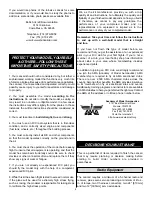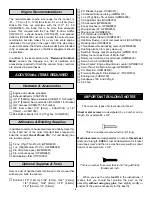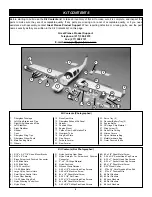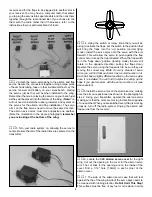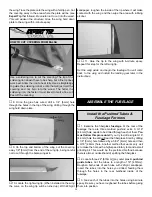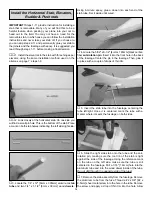
INTRODUCTION ................................................................2
IMAA ..................................................................................2
SAFETY PRECAUTIONS ..................................................3
DECISIONS YOU MUST MAKE ........................................3
Radio Equipment .........................................................3
Engine Recommendations...........................................4
ADDITIONAL ITEMS REQUIRED .....................................4
Hardware & Accessories .............................................4
Adhesives & Building Supplies ....................................4
Optional Supplies & Tools ............................................4
IMPORTANT BUILDING NOTES.......................................4
COMMON ABBREVIATIONS ............................................5
METRIC/INCH RULER ......................................................5
ORDERING REPLACEMENT PARTS...............................5
KIT CONTENTS.................................................................6
IMPORTANT INSTRUCTIONS ABOUT
WORKING WITH FIBERGLASS .......................................7
PREPARATIONS................................................................7
BUILD THE WING ..............................................................7
Install the Flaps & Ailerons ..........................................7
Install the Flap & Aileron Servo ...................................8
Install the Flap & Aileron Hardware & Pushrods .......11
Join the Wings ...........................................................12
ASSEMBLE THE FUSELAGE .........................................13
Install the Pushrod Tubes & Fuselage Formers.........13
Install the Horizontal Stab, Elevators,
Rudder & Pushrods ...................................................15
INSTALL THE ENGINE & MUFFLER..............................17
Install the Engine .......................................................17
Join the Muffler ..........................................................18
Install the Nose Wheel...............................................19
Install the Main Landing Gear....................................23
Install the Fuel Tank ...................................................25
INSTALL THE RADIO SYSTEM ......................................25
Install the Receiver & Battery ....................................28
Receiver Antenna Routing .........................................28
INSTALL THE COWL.......................................................29
GET THE MODEL READY TO FLY..................................30
Check the Control Directions .....................................30
Set the Control Throws ..............................................30
Balance the Model (C.G.) ..........................................31
Balance the Model Laterally ......................................32
PREFLIGHT .....................................................................32
Identify Your Model.....................................................32
Charge the Batteries..................................................32
Balance the Propellers...............................................32
Ground Check............................................................32
Range Check .............................................................32
ENGINE SAFETY PRECAUTIONS .................................33
AMA SAFETY CODE (excerpt) ......................................33
IMAA SAFETY CODE (excerpt) .....................................33
CHECK LIST....................................................................35
FLYING.............................................................................35
Fuel Mixture Adjustments ..........................................35
Takeoff .......................................................................36
Flight ..........................................................................36
Landing ......................................................................36
ENGINE MOUNT TEMPLATE..........................................39
Of the many airplanes flying today, the Lancair (Lance-air)
is considered by many to be a “Modern Classic.” With its
sleek, clean lines, it has a very graceful appearance both on
the ground and in the air. Great Planes is proud to bring you
this wonderful classic in an easy to fly model that will
impress you by the way it flies and its good looks in the air.
We are sure you will get years of enjoyment from your
Lancair.
For the latest technical updates or manual corrections to the
Lancair, visit the web site listed below and select the Great
Planes Lancair ARF. If there is new technical information or
changes to this model, a “tech notice” box will appear in the
upper left corner of the page.
http://www.greatplanes.com/airplanes/index.html
For information on the full-size Lancair visit this web site:
http://www.lancair.com
The Great Planes Lancair is an excellent sport-scale model
and is eligible to fly in IMAA events. The IMAA (International
Miniature Aircraft Association) is an organization that
promotes non-competitive flying of giant-scale models. If
you plan to attend an IMAA event, contact the IMAA for a
copy of the IMAA Safety Code at the address or telephone
number below.
IMAA
205 S. Hilldale Road
Salina, KS 67401
(913) 823-5569
www.fly-imaa.org/imaa/sanction.html
Scale Competition
Though the Great Planes Lancair is an ARF and may not
have the same level of detail as an “all-out” scratch-built
competition model, it is a scale model nonetheless and is
therefore eligible to compete in the
Fun Scale class in AMA
competition (we receive many favorable reports of Great
Planes ARFs in scale competition!) In Fun Scale, the
“builder of the model” rule does not apply. To receive the five
points for scale documentation, the only proof required that
a full-size aircraft of this type in this paint/markings scheme
did exist is a single sheet such as a kit box cover from a
plastic model, a photo, or a profile painting, etc. If the photo
is in black and white, other written documentation of color
must be provided. Contact the AMA for a rule book with full
details.
IMAA
INTRODUCTION
TABLE OF CONTENTS
2
Summary of Contents for Lancair ES
Page 40: ......



